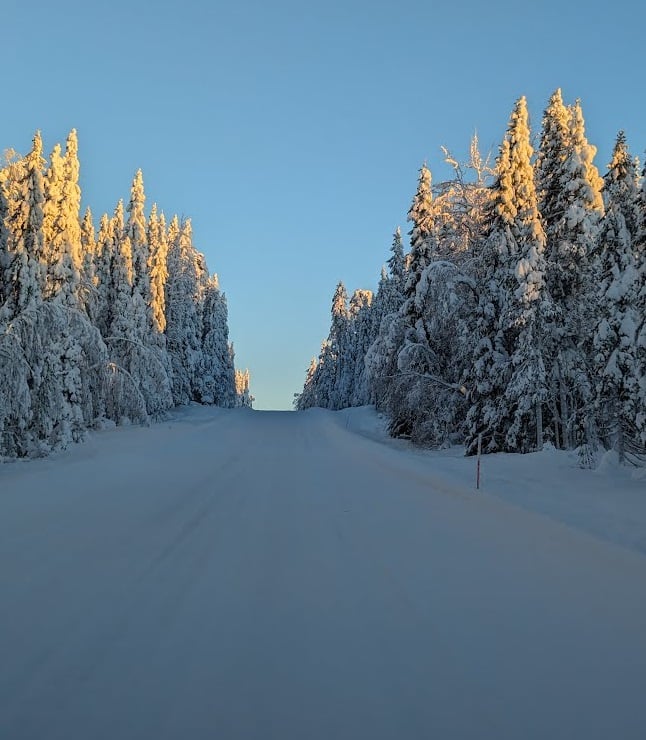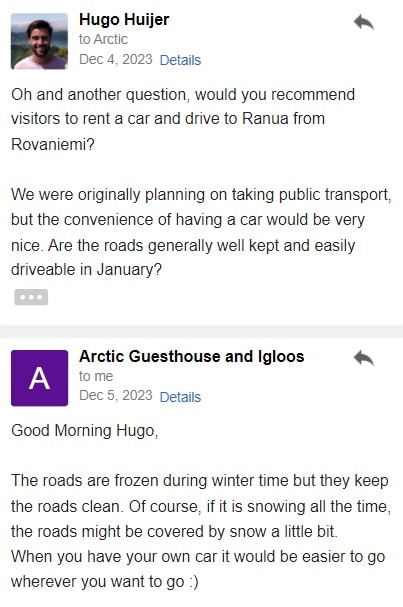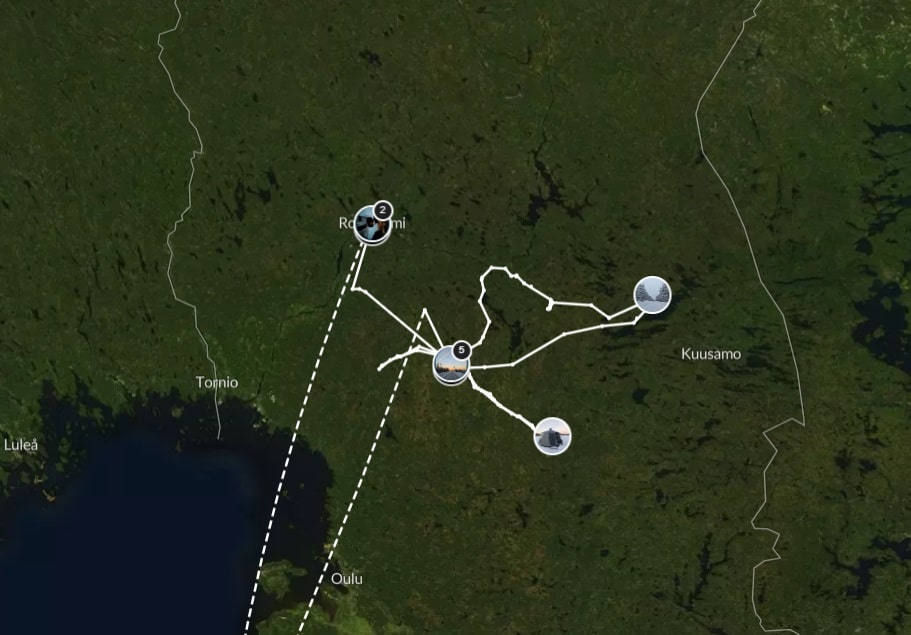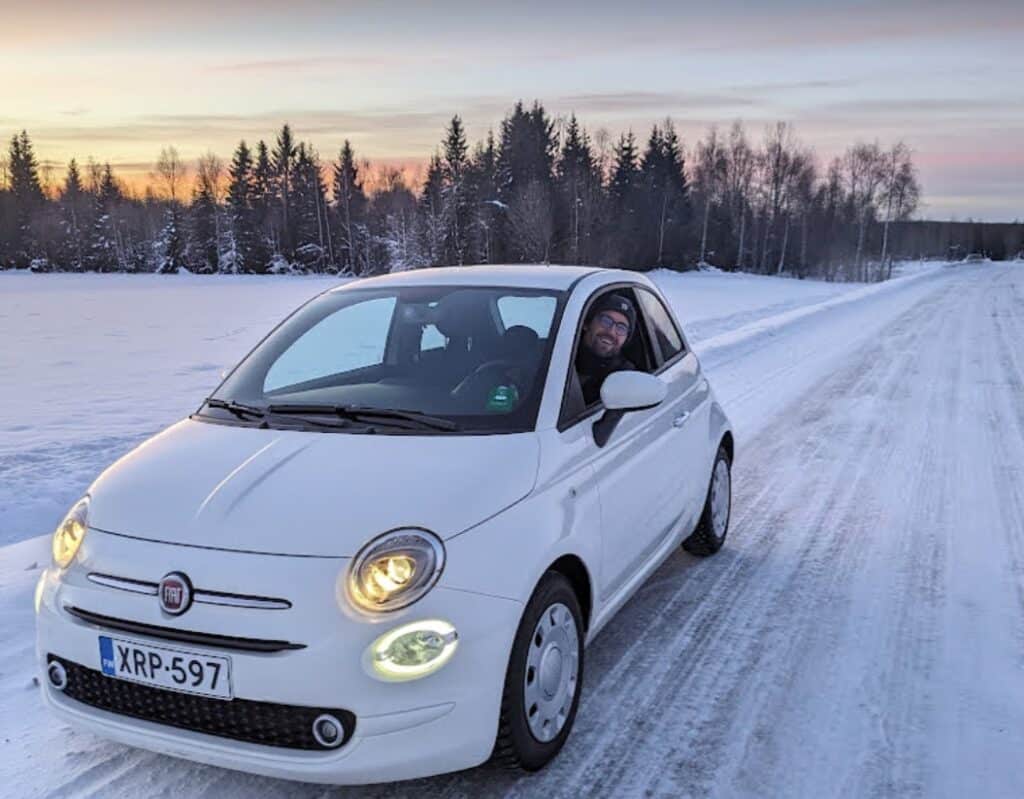Rachel and I visited Finnish Lapland in January 2024. It was freezing every single day, with temperatures dipping as low as -31 degrees Celsius (or -24 degrees Fahrenheit). The roads were covered with snow and ice, but we still wanted to explore as much of the area as possible. So how difficult is it really to get around in a car in Lapland in winter?
In this post, I’ll share our experiences, the cheap(est) car we rented, our doubts beforehand and how quickly these doubts melted away as soon as we started driving our car.
This post is about Finland, but the roads are the same in Sweden and Norway.
Contents
What are the roads like in Finland / Lapland in winter?
Here are some pictures of what the winter roads are like in Finland / Lapland:

The main highway was the only road where we could actually see the asphalt underneath the ice.

Most of the roads we drove looked more like this: densely-packed snow and ice, with snowy berms on either side.
Here’s a video we made that summarizes the driving conditions in Lapland:
When I planned this trip, I had no idea if it was even possible to get around by car in winter. I expected that it wouldn’t be possible, and that we would have to depend on tours and public transport.
But I emailed my accommodation and asked them: How are your roads, and would you recommend me to rent a car?

This reply made me confident, and that night, I booked our rental car.
Do you really need a car in winter Lapland?
In hindsight, I don’t know why I even considered going to Lapland without a car. The public transport system doesn’t take you to all the beautifully remote landmarks, and being totally dependent on tours will be a big hit to your savings.

Our car allowed us to:
- Visit the beautiful Syote National Park.
- Drive from Rovaniemi airport to our wonderful accommodation in Ranua.
- Visit the Riisitunturi National Park.
- Visit the amazing frozen waterfalls at Korouoma.
- Enjoy the freedom of just driving down any road you want! This is something Rachel and I really enjoy doing!
Without our car, we would have had to spend lots of money to be able to see these things.
Why you don’t need a big car
We rented the cheapest car available to us: a Fiat 500 Hybrid!
We paid 420 Euros for our 7-day rental period, so 60 Euros a day. We thought this was a good deal, as it gave us the freedom to go where we wanted, do our own groceries, and visit some National Parks on our own.

Do you need 4WD in Lapland in winter conditions?
Do you need 4WD in winter Lapland? In my opinion, you don’t need it. Our 2WD Fiat 500 drove like a charm, and we never felt like we needed the extra traction!
We were able to drive up small hills like the one in this picture without any issues:

Fuel is relatively expensive in Finland, so we were happy with the great fuel economy of this small little hybrid.
Like most small cars in Europe, this car had a manual transmission. I’ve always driven a manual car, and in snowy conditions like these, I prefer the extra control it provides!
What it’s like driving in Lapland in winter?
There’s snow.
Lots of snow.
When we first landed in Rovaniemi, we were picked up by our AirBnb host. And from our perspective – the perspective of people who’ve never seen so much snow – our host was driving extremely reckless. He drove as if there was no snow at all. He was exiting highways at regular speed, didn’t slow down for corners and bends, and acted like it was no big deal at all.
In the meantime, we were in the backseat thinking he was going to get us in a car crash.
But as soon as we picked up our own car, it turned out the locals are right:
Driving in winter conditions in Lapland – whether that’s Finland, Norway or Sweden – is no big deal at all. It’s easy-peasy.
And it’s all because of their tires:

These are studded tires, and every car in Lapland has them in winter.
The studs are like nails, and they protrude slightly from the tire when you’re driving on ice or snowy roads. As a result, the studs penetrate the snow and provide the car with the needed traction.
As soon as we started driving in our own little rental car, we had an A-ha moment. These tires made all the difference. It was almost as if we were driving on an asphalt road.
So, can you safely get around in a car in winter Lapland? Definitely! We felt super confident in our car and were able to see and do everything we wanted because of our rental car.
That said, there are still some important things to consider. Even though your tires are amazing, you are still the driver of the vehicle and responsible for your own safety and that of others.
6 things to know before driving in winter in Lapland
Before you start driving in the snow in Lapland, here are some things you should consider:
1. Don’t drive like a maniac
This one feels obvious, but I’ll just say it anyway.
There’s snow everywhere, and the roads are super slippery. Don’t get over-confident and exceed the local speed limits.
When we were driving on the snowy highways, the speed limit was 100 km/h. But we always stayed a little below that – roughly 80 km/h – which felt right for us. Sure, the locals passed us at higher speed but that’s okay.
Important: If you’re climbing a hill and can’t see what’s on the other side: take it extra slow. Chances are there’s something on the road – or a big truck heading your way – that forces you to make an emergency stop. If you do this at full speed, you will get in a crash.
2. Watch out for big trucks and heavy vehicles
This one’s important, as there was no other website that warned us about this.
If you see a big truck approaching at high speeds on the highway: slow down. Look closely at the trail of snow it leaves behind. On more than one occasion, the truck threw up a massive storm of snow that left us completely in the dark.
It was as if someone turned off all the lights. We couldn’t see the road, the berm, or the direction in which we were going.
If you don’t slow down and get caught in a trail, you can easily get yourself crashed.
We filmed one of these and posted it to our Instagram page, so check out this video if you want to get an idea:
3. Bring warm clothes, water and make sure you have enough fuel in the tank
As I said in the intro, temperatures got as low as -31 degrees Celsius (or -24 degrees Fahrenheit).
If you aren’t well prepared for these conditions, you’re at serious risk of hypothermia.
So, before you go out to remote destinations:
- Make sure you bring warm clothes with you: You shouldn’t have to depend on your car’s heating system. Even though the odds are rare, if your car breaks down you’ll be at risk. Especially if you’re in a remote area with no cell service.
- Bring water: In these cold temperatures, you get dehydrated pretty easily. I guess it’s because it’s so cold that you don’t feel like you’re thirsty. But still, bringing a bottle of water with you is always a good idea!
- Make sure you have enough fuel in the tank: This one speaks for itself, but the goal here is to prevent yourself from being stranded in the freezing cold. Fuel is pretty important for that goal. Even if your car breaks down, you still want to keep the engine idling if you can. That way, you can stay nice and warm inside while you wait for help. You don’t want to be worrying about your fuel level at this point!
4. Warm up your vehicle before taking off
This is something every local does. Oftentimes, they even keep their car running in the parking lot when they go inside for a quick errand.
Turn on your engine 10 minutes before leaving. This allows your engine oil to get up to temperature. And since good oil circulation is one of the most crucial factors for a healthy engine, your rental company will be thankful.
But this also benefits you! If your engine has been running for 10 minutes, you’ll be able to enjoy the warmth of your heater right as you drive off!
5. Use your bright headlights as soon as the sun sets
It gets dark really quickly in winter Lapland. Around this time, most animals become a little more active. So to make yourself more visible, you should try to turn on your bright headlights as soon as you can.
You don’t want to kill a reindeer, and you definitely don’t want to get yourself killed by hitting a moose.
Note: It’s mandatory to turn on your regular headlights at all times, even when it’s in the middle of the day.
6. Control the air circulation in your car
When the temperatures drop to extreme cold, you want to be as warm as possible in your car. But there are some considerations here:
- Do you direct the warmth to yourself or to your windshield?
- Do you recirculate the air or do you allow fresh air to enter the ventilation system?
I get it. You want to stay as warm as you can, and so you turn on the heating at full blast and point it all towards yourself. Also, you push the ventilation circulation button so that the car only recirculates the warm air that’s already in the car. This prevents your car from ventilating fresh (cold) air from the outside.
But if you do these things, you might find your windshield frozen from the inside!
That’s because we breathe out a lot of water vapor as we exhale. Warm air from inside the car meets your cold windscreen and turns your exhaled vapor into water. This causes windscreen fog that impedes your vision. And if you don’t watch out, that fog will freeze and you’ll have a problem on your hands.
To prevent this from happening, you should consider pointing your ventilation at your windows to prevent condensation from freezing. Also, if you allow fresh air to circulate inside your car, you can lower the humidity in your car.
My advice: rent a car that has heated seats! Our small Fiat 500 hybrid was the cheapest car we could rent, and it had heated seats (even though we only found out on the last day of our trip…)
Wrapping up
So, is it safe to drive in winter Lapland? Yes, it’s completely safe and you shouldn’t worry too much about it. As long as you drive cautiously and follow these 6 tips, you should be fine!
Is there anything you want to know about driving in snowy conditions that I didn’t include in this article? Let me know in the comments below and I’ll get back to you!